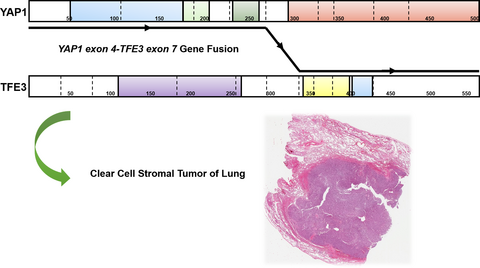YAP1–TFE3 gene fusion variant in clear cell stromal tumour of lung: report of two cases in support of a distinct entity
Abstract
Aims
Clear cell (haemangioblastoma-like) stromal tumour of the lung is a newly described, rare pulmonary neoplasm. Recurrent YAP1–TFE3 gene fusions have recently been reported in three cases. We describe two additional cases and confirm the characteristic YAP1–TFE3 gene fusion.
Methods and results
Two mesenchymal tumours of lung were identified from our soft tissue pathology consultation services and RNA sequencing was performed. Both cases were in male patients, aged 35 and 77 years. Both presented as solitary lung nodules measuring 3.9 and 7.5 cm in greatest dimension. Histopathologically, the tumours were composed of epithelioid to plump spindle cells arranged in packets and solid sheets. The cells showed fusiform to ovoid nuclei with open chromatin, variably prominent nucleoli and scant to moderate, clear to eosinophilic cytoplasm. Cytological atypia and significant mitotic activity were minimal. None of the tumours expressed lineage-specific immunophenotypical markers. Both cases were diffusely positive for nuclear TFE3. Unlike YAP1–TFE3-fused epithelioid haemangioendothelioma, for which the fusion breakpoint occurs in YAP1 exon 1 and TFE3 exons 4 or 6, the fusion breakpoints of these tumours were located in YAP1 exon 4 and TFE3 exon 7. Following complete surgical resection, neither of the tumours has recurred or metastasised (follow-up period 6–7 months).
Conclusions
We validate the presence of YAP1–TFE3 gene fusion in a unique primary mesenchymal tumour of lung, adding additional support for clear cell stromal tumour of the lung as a distinct entity.
Graphical Abstract
Conflicts of interest
There are no conflicts of interest to report for any of the authors.





